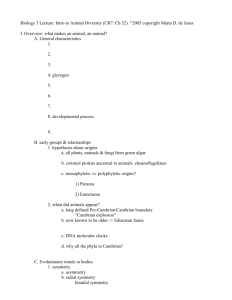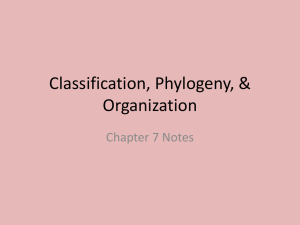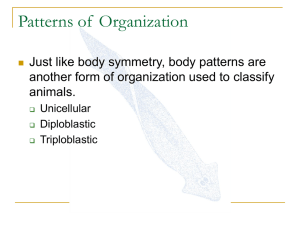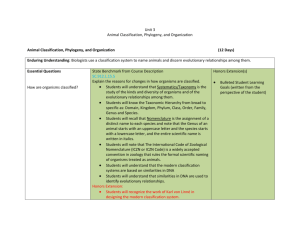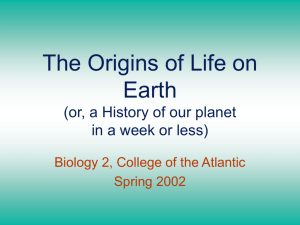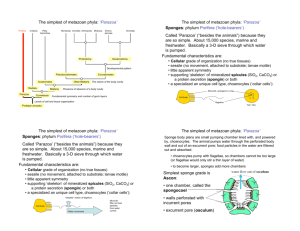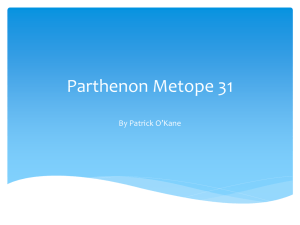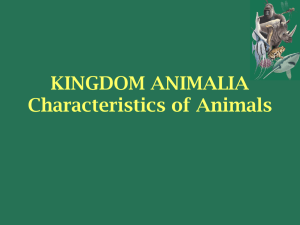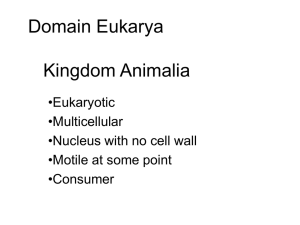Lab 3: Animal Diversity
advertisement
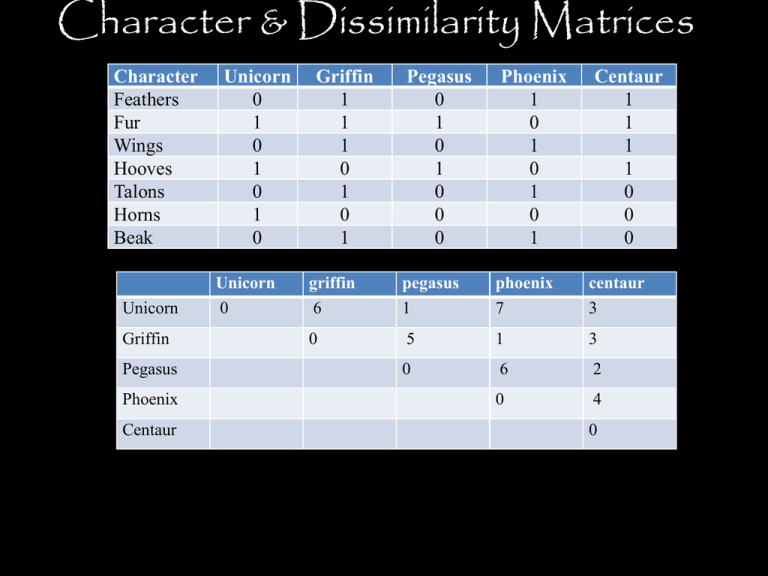
Character & Dissimilarity Matrices Character Feathers Fur Wings Hooves Talons Horns Beak Unicorn Griffin Pegasus Phoenix Centaur Unicorn 0 1 0 1 0 1 0 Unicorn 0 Griffin 1 1 1 0 1 0 1 Pegasus 0 1 0 1 0 0 0 Phoenix 1 0 1 0 1 0 1 Centaur 1 1 1 1 0 0 0 griffin 6 pegasus 1 phoenix 7 centaur 3 0 5 1 3 0 6 2 0 4 0 Protist Diversity Wrap-Up • Make sure you know how to build a phylogentic tree of the protists – Are plastids homologous or analogous? • Put the supergroup and subgroup of each protist examined on your tree Lab 3: Animal Diversity Lab Goals • Recognize the major phyla of animals • Understand the developmental characters that distinguish the different groups and how these can inform our understanding of evolution (chart on pg. 49) • More practice with phylogenetic trees!!!! Fig. 32-1 What are animals? • • • • • Eukaryotic Heterotrophic Multicellular Diploid Are motile at some stage You are here Some Terminology…. Symmetry: pattern of body organization – Asymmetry – Radial symmetry – Bilateral symmetry Why is embryonic development important in our understanding of evolution? • Evolutionary Developmental Biology (“Evo-Devo”) – Comparisons of developmental characters in different organisms can often reveal ancestral relationships – Excellent characters for use in building phylogenies Ernst Haeckel 1892 Tissues • Parazoa-no tissue differentiation • Eumetazoa-has true tissues – Diploblastic—two cell layers – Triploblastic—three cell layers Diploblastic Diploblastic Diploblastic Triploblastic Diploblastic Development Triploblastic Development Protostomes (“mouth first”) Blastopore= mouth Deuterostomes (“mouth second”) Blastopore= anus Videos • Development of the Blastula • Gastrulation Triploblastic Animals Have one or two body cavities: 1) Archenteron = gut 2) May also have either a: • Pseudocoelom exterior lined by mesoderm, interior lined by endoderm • Coelom cavity completely lined with mesoderm archenteron coelom Acoelomate Psuedocoelomate Coelomate Protostomes: Two Clades • Lophotrochozoa – Fun to say! – Trochophore larvae – Lophophore • Used for filter feeding • Ecdysozoa – Shed an external cuticle or exoskeleton – Why is this done?? Flow Chart True Tissues? yes no Parazoa Eumetazoa Number of Germ Layers? Asymmetry two three Triploblastic Diploblastic Radial symmetry Fate of blastopore? mouth Protostome Acoelomate, Pseudocoelem, or Coelem Which clade? Lophotrochozoa Trochophore larvae or lochophore (or neither) ? Bilateral symmetry Ecdysozoa anus Deuterostome Coelom Today’s Lab • • • • Work through all stations (use flowchart!) Examine organisms in tank Complete lab report in class Show me your tree! Next Week • 20 pt quiz (protists and animals) – you may use protist “cheat sheet” – All words on Table 3.3 in the Animal Diversity lab will be in a word bank on the quiz (i.e. know the definition but don’t worry about spelling) • Animal Lab Report DUE (animal lab is first one worth points!!) • Read Pig Dissection Lab and BRING GLOVES

